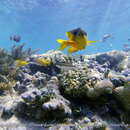en
names in breadcrumbs


Juvenile analogues: New recruits of S. variabilis are separated from S. planifrons and S. adustus by having stripes along with the spots on the head and iris and from S. partitus by having a dorsal-fin ocellus. New recruits of S. variabilis develop a prominent caudal-peduncle saddle mark, which serves to distinguish them from the otherwise very similar S. leucostictus and S. diencaeus. Recruits that have not developed the saddle can be separated from S. leucostictus by having the ocellus well onto the body (less useful characters include usually no additional row of spots between the top stripe on the head and the upper-eye stripe, and sparser spotting on the anterior dorsal fin). Early recruits that have not developed the saddle or have an incipient saddle are difficult to separate from S. diencaeus when life colors are not apparent (S. diencaeus recruits should not have the anterior dusky blue wash on the head and upper body and the stripes are more magenta than blue). The problem is that some S. variabilis (up to 20 mm SL) have indistinct caudal-peduncle saddles and many S. diencaeus of the same size have similar-appearing indistinct saddles. In that case, the distinction becomes more subtle: S. variabilis have more dusky blue shading over the head and body, especially including the posterior dorsal fin and the anal fin while this area is not at all blue in S. diencaeus. Unfortunately, degrees of duskiness are poor characters to separate individuals. DNA sequence comparisons underway at present should resolve the line of separation.
Early juvenile markings: New recruits (10-15 mm SL) of S. variabilis have a pattern of blue stripes and spots on the head and upper body with two spots and a stripe on the iris. The upper part of the head and anterior body have a dusky blue background color. There is a large black ocellus ringed in blue centered on the last two dorsal-fin spines and first three dorsal-fin soft rays. The ocellus is typically 50% on the fin and 50% on the body. The blue edging below the ocellus on the body is usually an intact blue line and it comes close to the lateral line (usually less than one scale away). There is a characteristic blue-edged black saddle-spot on the caudal peduncle just behind the last dorsal-fin ray.
Later juveniles (over 20 mm SL) are are yellow with a blue (often bright blue) upper head and anterior body and dorsal fin with numerous iridescent blue stripes and spots, a dorsal-fin ocellus over the body and fin (moving off the body when large juveniles over 30 mm SL), and a prominent black caudal-peduncle saddle.
Diagnosis: Damselfishes with 12 dorsal-fin spines and a mode of 15-16 dorsal-fin soft rays indicate Stegastes and Microspathodon chrysurus. Fin-ray counts broadly overlap among Stegastes with most species having 13-14 soft anal-fin rays and 18-20 pectoral-fin rays (S. adustus and M. chrysurus have a mode of 21 pectoral-fin rays). Given this overlap, larvae and even early juveniles can require DNA sequencing to reliably distinguish the species.
Stegastes variabilis, commonly known as the Brazilian cocoa damselfish, is a species of damselfish in the family Pomacentridae, found on coral reefs in the western Atlantic Ocean and off Brazil. They are often solitary fish.[2]
The genus name is Greek for stegastos, which means covered. Formerly, the Caribbean cocoa damselfish was considered as conspecific with the Brazilian cocoa damselfish, but the population from the Caribbean is genetically very distinct from it.[2]
The Brazilian cocoa damselfish is an oval, laterally compressed fish and grows to about 12.5 centimetres (4.9 in) long. The top of the head and the snout bear several blue stripes. The top of the body is generally dark brown or blue or brown and shades to yellow below. The sides are finely barred with obliquely vertical dark lines. There are two small black spots, one above the pectoral fins and the other on the top of the caudal peduncle. The large dorsal fin has 12 spines and 14 to 17 soft rays. The anal fin has two spines and 12 to 15 soft rays. The caudal fin is shallowly forked and has rounded lobes.[2]
Brazilian cocoa damselfish are found in the western Atlantic by Brazil.[2] They are marine and reef-associated. They do not migrate and have a depth range of 0 to 30 m.[2]
Adults feed mainly on benthic algae but also on sponges, ascidiacea and anemones, while juveniles feed on invertebrates such as harpacticoid copepods and nemerteans.[2]
In the breeding season, the female lays eggs on the seabed where they are attached to empty shells, stones or other objects and fertilized by the male. He then guards them, aerates them and chases away intruders.[2] They are aggressive when breeding. Also there is distinct pairing during breeding.[2]
Stegastes variabilis, commonly known as the Brazilian cocoa damselfish, is a species of damselfish in the family Pomacentridae, found on coral reefs in the western Atlantic Ocean and off Brazil. They are often solitary fish.